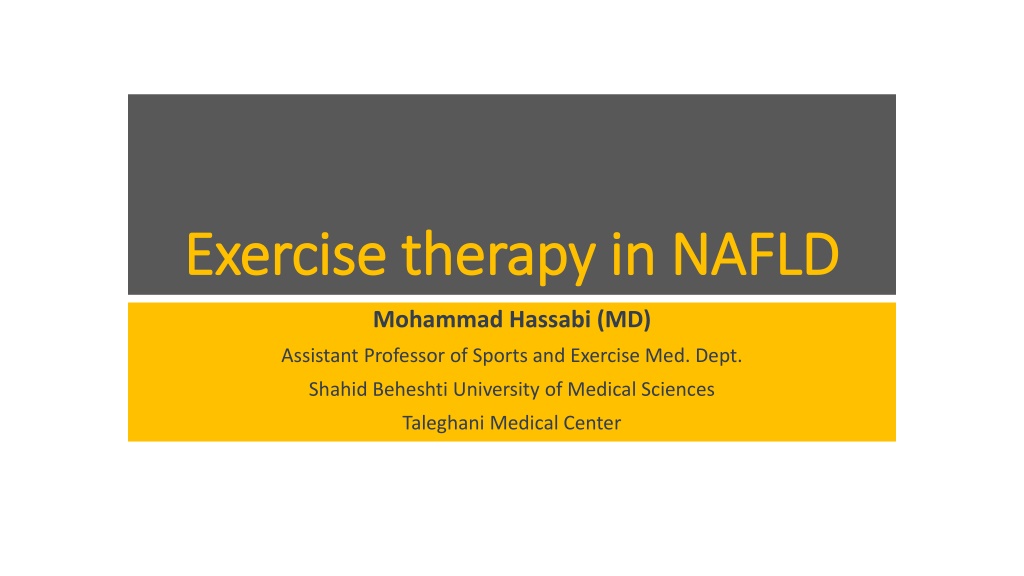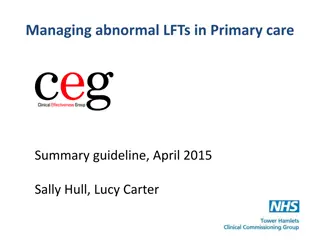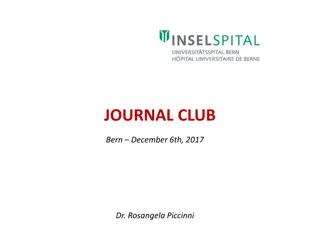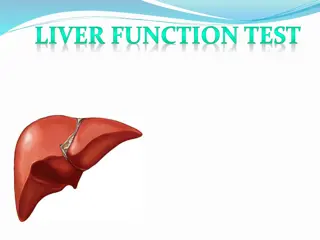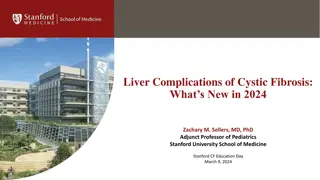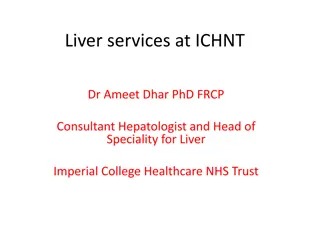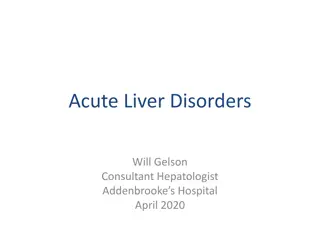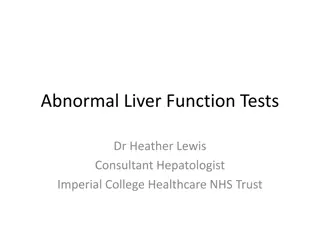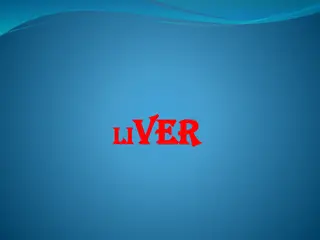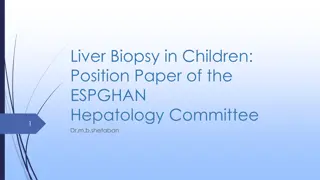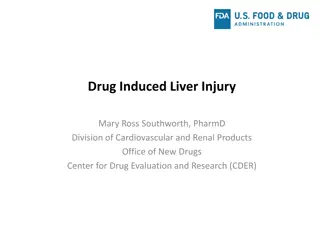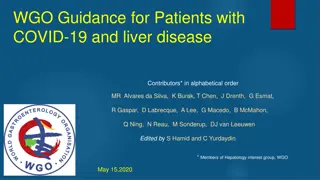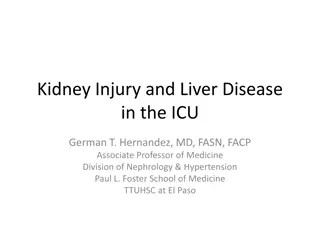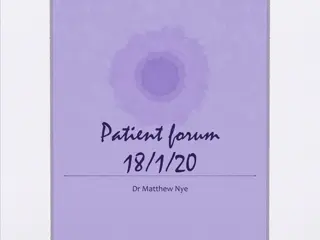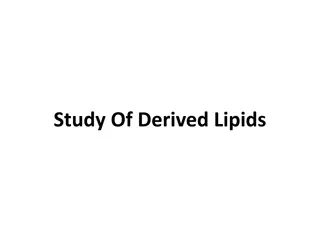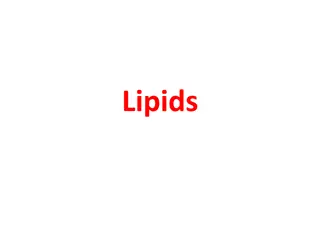Benefits of Exercise Therapy in Nonalcoholic Fatty Liver Disease (NAFLD)
Exercise therapy plays a crucial role in managing nonalcoholic fatty liver disease (NAFLD) by improving hepatic aminotransferases and reducing steatosis. Lifestyle modifications, including increased physical activity, are essential in the treatment of NAFLD. This includes aerobic exercise, resistance training, flexibility training, and overall lifestyle modification. Dr. Mohammad Hassabi emphasizes the importance of exercise in improving cardiovascular fitness, muscular strength, and flexibility. Utilizing different types of exercises can enhance overall physical fitness and quality of life for individuals with NAFLD.
Download Presentation

Please find below an Image/Link to download the presentation.
The content on the website is provided AS IS for your information and personal use only. It may not be sold, licensed, or shared on other websites without obtaining consent from the author. Download presentation by click this link. If you encounter any issues during the download, it is possible that the publisher has removed the file from their server.
E N D
Presentation Transcript
Exercise therapy in NAFLD Exercise therapy in NAFLD Mohammad Hassabi (MD) Assistant Professor of Sports and Exercise Med. Dept. Shahid Beheshti University of Medical Sciences Taleghani Medical Center
Physical activity Exercise Sports
Physical fitnessis considered a measure of the bodys ability to function efficiently and effectively in work and leisure Components of physical fitness Physiological Metabolic Morphological Bone integrity Other Health related Cardiovascular fitness Flexibility Muscular endurance Muscle strength Body composition Skill related Agility Balance Coordination Power Speed Reaction time Other
Aerobic exercise Aerobic exercise Incorporate Rhythmic use of large groups of muscle Performed at moderate levels of intensity Extended periods of time Aimed to improve cardio-respiratory fitness And increasing energy expenditure Walking, jogging, swimming or bicycling are some examples of aerobic activities
Resistance training Resistance training Resistance training is a form of muscular fitness training in which each effort is performed against a specific opposing force
Flexibility Training Flexibility Training Flexibility training can be included as part of the warm-up or cool-down, or undertaken at a separate time.
Lifestyle Modification Lifestyle Modification To date there is no effective drug treatment for nonalcoholic fatty liver disease (NAFLD). A combination of dietary modifications and increased physical activity remains the mainstay of NAFLD therapy Exercise is now an established therapy for the management of NAFLD Based on the 2012 published practice guidelines, lifestyle intervention has shown to improve hepatic aminotransferases along with steatosis
In overweight or obese NAFLD patients, weight reduction mediated by dietary and exercise therapies decreases liver fat content 7 10% reduction in body weight can lead to significant reduction in hepatic steatosis, improved NAFLD activity score and the reversal of NASH Human data clearly demonstrate that regular exercise itself reduces liver fat and can do so in the absence of clinically significant weight loss
the possible mechanisms related to the possible mechanisms related to beneficial effects of aerobic exercise beneficial effects of aerobic exercise
Modulating intrahepatic fat content Modulating intrahepatic fat content exercise could regulate hepatic lipid metabolism by modulating hepatic - oxidation and reducing hepatic lipogenesis exercise can ameliorate NAFLD by regulating SREBP-1c and PPAR expression and activities - hepatic steatosis is highly associated with the dysregulation of sterol regulatory element-binding protein-1c (SREBP-1c), a transcription factor that regulates genes which enhance triglyceride synthesis, with associated reductions in hepatic capacity for fatty acid oxidation - PPAR , a nuclear receptor protein transcription factor regulating lipid metabolism Leon A. Adams et al. CMAJ 2005;172:899-905
Decreasing NAFLD Decreasing NAFLD- -induced oxidative stress induced oxidative stress There is a close relationship between oxidative stress and the severity of NASH When oxidative stress occurs in NAFLD, two general products are often excessively generated: reactive oxygen species (ROS) and reactive nitrogen species (RNS) exercise attenuates the oxidative damage triggered by NAFLD partly through enhancing the antioxidant enzyme level (such as catalase (CAT), GPx and SOD-1) and regulating ROS level
Reducing hepatic inflammation Reducing hepatic inflammation Hepatic inflammation, another major event in NAFLD, is also a key transitional event that progresses from a simple steatosis to NASH Aerobic exercise decreases the expression of pro-inflammatory mediators TNF- and IL-1
Ameliorating NAFLD Ameliorating NAFLD- -induced hepatocyte apoptosis induced hepatocyte apoptosis The occurrence of apoptosis in hepatocytes is often seen in NAFLD patients and experimental animal models Luo et al, demonstrated that chronic resistance exercise reduces the level of cytochrome C released from the mitochondria to the cytosol as well as the expression level of cleaved caspase-3 in aged rats, suggesting that exercise inhibits mitochondria-dependent apoptosis. treadmill exercise reduces diabetes-triggered apoptosis by enhancing the p-AKT expression level in diabetic rats Additionally, it has been shown that hepatocyte apoptotic markers are diminished aerobic excercise reduces hepatocyte apoptosis through enhancing the p- AKT level and down-regulating the apoptotic markers such as caspase-3
Triggering Triggering Hepato Hepato- -protective autophagy protective autophagy Autophagy is a cellular process of degradation of intracellular components to recycle cellular waste and maintains energy balance under starvation Even though the mechanism has not been shown, a reasonable speculation could be deduced that exercise is considered as a newly defined stimulus that triggers autophagy, leading to the attenuation of NAFLD pathology ultimately
The optimal dose patients with NAFLD dose of exercise for NAFLD
Aerobic exercise training Aerobic exercise training There is no specific exercise guideline for NAFLD most studies have conformed to doses recommended by the ACSM for in apparently healthy adults: moderate-intensity for 30 min at least 5 d/w, or vigorous cardiorespiratory exercise training for 20 min 3 d/w Exercise interventions meeting these guidelines consistently demonstrate reduction in liver fat of 10 43% in patients with NAFLD
Keating et al, recently observed in previously inactive obese adults significant reduction in intrahepatic lipid (IHL) with exercise training doses which emphasized: - volume over intensity (45 60 min of aerobic exercise at 50% VO2peak on 4 days per week, mean relative IHL reduction of 28%) or - intensity over volume (30 45 min of aerobic exercise at 70% VO2peak on 3 days per week, mean relative IHL reduction of 29%) Interestingly, a mean 18% relative reduction in IHL was also observed with prescription of low-to-moderate intensity and low-volume aerobic exercise (30 min at 70% VO2peak on 3 days per week), demonstrating that significant reductions can occur below the doses advocated in the current guidelines.
Progressive resistance training General exercise guidelines : 2 3 non-consecutive sessions/w Of the 9 studies employing PRT in isolation: - 5 observed a significant reduction in liver fat, three of which conformed with the abovementioned guidelines, - while 4 showed no benefit
Slentz Slentz CA, et al. Effects of aerobic CA, et al. Effects of aerobic vs vs resistance training resistance training The largest study to date which has directly compared aerobic exercise with PRT observed significant reduction in liver fat score (assessed via attenuation of computed tomography) with 8 months of aerobic exercise training but not with PRT in overweight adults 144 subjects 18 70 yr old, overweight, sedentary,
There is no evidence to suggest that exercise has an effect on NASH Cross-sectional data suggest that vigorous exercise intensity per se is required for histological improvement in the liver Recent research from obese rodent models also suggests a superior benefit of high-intensity training compared with moderate-intensity continuous exercise on liver fat and markers of liver injury typically associated with NASH
Kistler KD, et al. Kistler KD, et al. Physical activity recommendations, exercise intensity, and histological Physical activity recommendations, exercise intensity, and histological severity of nonalcoholic fatty liver disease. Am J severity of nonalcoholic fatty liver disease. Am J Gastroenterol Gastroenterol 2011 2011 a retrospective analysis of adults (N=813) with biopsy-proven NAFLD Their findigs support an association of vigorous but not moderate or total exercise with the severity of NAFLD
Cho J, et al. Effect of training intensity on nonalcoholic fatty liver Cho J, et al. Effect of training intensity on nonalcoholic fatty liver disease disease Animal study The intensity-dependent benefit of exercise training against hepatic steatosis was associated with greater activation of VIT on hepatic AMP-mediated protein kinase in conjunction with greater suppressive effect of VIT on hypoadiponectinemia, downregulation of the Adiponectin receptor 2 signaling pathway, and upregulation of the NF- B signaling pathway in the liver. The current findings suggest that VIT is an alternative way of exercise training to combat hepatic steatosis associated with an obese and impaired glucose tolerance phenotype.
However, until further evidence is available from human clinical trials, exercise for patients with NASH should be prescribed at similar exercise levels, cognizant of co-morbidities and in conjunction with lifestyle changes and pharmacotherapy
Safety of vigorous exercise in Safety of vigorous exercise in clinical populations clinical populations
Vigorous physical activity may be contraindicated in patients with, or at risk of, cardiovascular disease, which includes those with NAFLD. Vigorous exercise should only be initiated after appropriate pre- screening. Available evidence suggests that vigorous exercise is safe in patients with coronary artery disease but pre-medical evaluation should include 12-lead electrocardiography (stress testing) and appropriate specialist review if indicated.
Exercise Recommendations Exercise Recommendations
Based on current evidence 150 300 min per week of moderate- to vigorous-intensity (50 70% VO2peak) aerobic exercise, performed on a minimum of 3 d/w for hepatic benefits in patients with NAFLD While evidence supports the prescription of aerobic exercise in the first instance, performing PRT for 2 3 days per week (3 sets of 8 12 Reps at an intensity of 70 85% 1RM) may provide additional benefit for optimizing insulin sensitivity and improving muscle strength and function
Ultimately, exercise prescription should be individualized to promote adoption and long term adherence to the exercise regimen, which may be facilitated by behavioral and cognitive strategies
References Guo, R., et al. (2015). "Beneficial mechanisms of aerobic exercise on hepatic lipid metabolism in non-alcoholic fatty liver disease." Hepatobiliary Pancreat Dis Int 14(2): 139-144. Keating, S. E., et al. (2015). "The benefits of exercise for patients with non- alcoholic fatty liver disease." Expert Rev Gastroenterol Hepatol 9(10): 1247-1250. KASL clinical practice guidelines: Management of nonalcoholic fatty liver disease, Clinical and Molecular Hepatology, 2013;19:325-348
